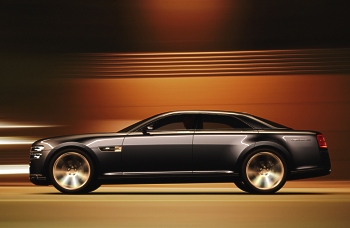
January 4, 2007
This Week:
-
Lincoln MKR Concept: Design Strategy for the Next Generation of Premium American Cars
-
A powerful start: The new Touareg V6 TDI in a severe test as a service vehicle in the Dakar Rally
-
Mitsubishi Motors Will Debut Two Models At NAIAS: Prototype X and the 2008 Lancer Lead Lineup
© 1998 - 2007
Copyright &
Disclaimer
Automotive Intelligence,
www.autointell.com
All Rights Reserved .
For questions please contact
editor@autointell.net
|
Ford Interceptor: The American Muscle Concept The Interceptor concept’s Ford Racing 5.0-liter Cammer engine runs on E-85 ethanol and produces 400 horsepower. This engine powered the Mustang FR500C to the 2005 Grand-Am Cup Championship in its first year of competition.
Building on its legacy of bold muscle cars, Ford is introducing a modern, all-American sedan concept that combines “Built Ford Tough” attitude with the sporty elegance of its iconic 1960s sedans. The Ford Interceptor concept comes equipped with a manual six-speed gearbox mated to a Ford Racing 5.0-liter V-8 Cammer engine that delivers 400 horsepower and runs on E-85 ethanol. The Ford Interceptor concept’s exterior design features substantial, sometimes brutish, surfaces and sections that give the concept its modern, powerful look. The Mustang-based concept features a traditional rear-wheel drive proportion that includes a short front overhang, long rear overhang and extended dash-to-axle ratio.
The Ford Interceptor also has a
low cabin and higher beltline, adding to the vehicle’s attitude
and sense of mystery. |
. |
|
|
“The Ford Interceptor concept is a pure sedan that speaks to performance car lovers everywhere,” said Freeman Thomas, director, North American Strategic Design. “These people might need more space, but they still appreciate the power and attitude that cars like this represent,” Painted a deep blue, the Ford Interceptor concept’s strength exudes from its strong, high shoulders. And much like on last year’s Ford F-250 Super Chief pickup concept, a single character line runs the length of the body side, slightly sloping downward as it reaches the back of the sedan. |
Signature Ford touches include the horizontal three-bar grille, which has been structurally integrated into the bumper beam, as well as “squircles” – or professionally square circle-shaped graphics – inside and out.

As a nod to performance purists, the ultimate muscle lies under the powered clamshell “shaker” hood, which caps a thoroughly detailed engine compartment that houses a 5.0-liter V-8 Cammer engine.
This is an upgraded variant of the 4.6-liter engine under the hood of the current production Mustang GT. The Cammer modular engine powered Ford Racing’s FR500C race car to the top of the Grand Am Cup’s GS class, achieving five victories on its way to the Drivers, Manufacturers and Team Championships in its first season of competition.
Inside, the Ford Interceptor concept is sleek and thoroughly modern, completed in contrasting black leather and metal finishes.
The dash, headliner and thick steering wheel are leather-wrapped. Plus, the Interceptor concept’s four low-back bucket seats are wrapped in thick black belt leather with exposed-edge seams and contrasting caramel stitching. The seats are accented with Ford GT-inspired squircle grommets finished with Titan Metal painted inserts.
Designed within a pair of squircles, the speedometer and tachometer are eye-catching. The needles for both start at center and move opposite each other as the speed and RPM climb.
Other clever touches include retractable headrests that deploy from the roof when the car is parked. They adjust fore and aft, as well as up and down for each occupant. Audio control panel and climate controls also are stowable.
While current three-point safety belts are extremely effective in reducing the risk of injury in a crash, Ford Motor Company is researching these two potential safety belt technologies as possible ways to further reduce injury risk in vehicle crashes.
A number of technical challenges still need to be overcome before such restraint systems could ever be used, but these technologies might one day further enhance safety belt effectiveness.
The four-point belt showcases a possible next-generation safety belt that is more comfortable and easier to use than traditional three-point belts, according to consumer research. Additionally, inflatable belts have been included in the rear seat of the concept to help better protect occupants in a variety of crashes.
(January 4, 2006)
| .
Homepage News Companies Management Publications Events Guestbook Search . |

